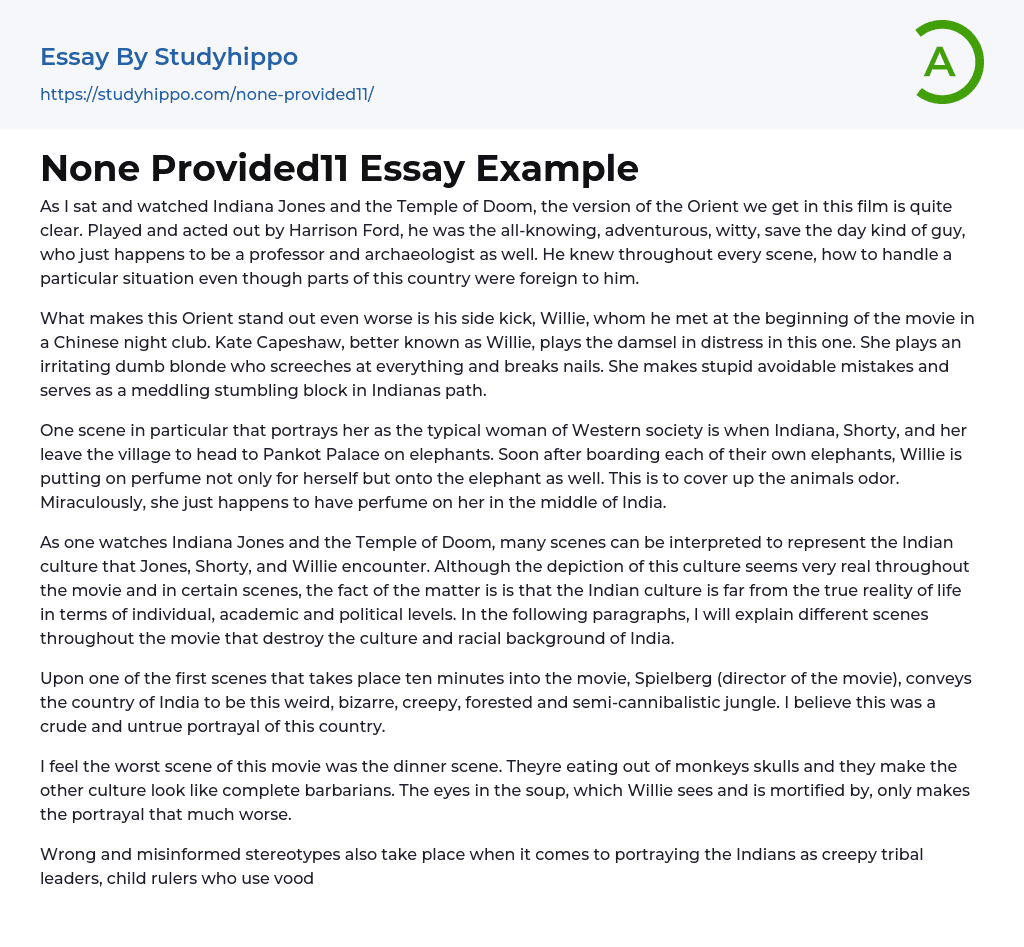As I observed the portrayal of the Orient in Indiana Jones and the Temple of Doom, it became evident that the film presented a specific representation. Harrison Ford's character, played by himself, embodied a knowledgeable, daring, clever individual who always managed to come to the rescue. Interestingly, he also happened to be a professor and archaeologist. Despite encountering unfamiliar aspects of this land, he skillfully handled every circumstance throughout the movie.
The negative perception of the Orient is intensified by the presence of Willie, Indiana's sidekick whom he encounters at a Chinese night club in the beginning of the movie. Known as Kate Capeshaw or Willie, she embodies a distressed damsel and an irritating dumb blonde who screeches and damages her nails. Her avoidable mistakes become obstacles to Indiana's journey. There is one scene that stands out where she exempl
...ifies the stereotypical Western woman; when she, Indiana, and Shorty depart from the village on elephants towards Pankot Palace, Willie not only applies perfume on herself but also on the elephant to conceal its odor. Interestingly enough, it seems she conveniently carries perfume with her in India. It is essential to realize that while there are several scenes in Indiana Jones and the Temple of Doom that seemingly portray Indian culture, these representations inaccurately reflect reality when it comes to individualism, academia, and politics. In the following paragraphs, I will examine various scenes from the film that undermine India's cultural background and racial identity. Within the first ten minutes of Spielberg's work, India is depicted as a strange, eerie jungle with cannibalistic tendencies—a crude and inaccurate portrayal of this country. The dinner scene particularly stands out as
being distasteful; it portrays individuals consuming food from monkeys' skulls which perpetuates a barbaric image of another culture. Adding eyes to their soup further worsens this negative depictionThe movie perpetuates stereotypes about Indians, portraying them as creepy tribal leaders, child rulers who use voodoo dolls, and villains who perform human sacrifices and remove hearts. These villains are presented without explanation or justification, simply as "big bad voodoo Indians." Spielberg seems to have deliberately included every ignorant stereotype he could think of. Knowing what I do about Indian art and religion, there are several aspects of the movie that I would change to provide a more accurate representation of India. This includes avoiding the portrayal of Indian culture as barbaric by not associating cooked food with civilization and uncooked food with barbarism. Additionally, I would eliminate the cliche use of voodoo dolls and child rulers. Initially unaware of these stereotypes in the movie, I only became upset after learning more about India's culture and way of life. Online research revealed that many critics disliked the film for its racist portrayals and stereotypes of Indians, considering it a disgrace on Harrison Ford's resume. Personally, I hold Spielberg responsible for contributing to existing hatred, racism, and stereotypes in our world.
Bibliography: Not provided
- Wall Street essays
- Dead Poets Society essays
- A beautiful mind essays
- Sherlock Holmes essays
- Our day out essays
- American Beauty essays
- Do The Right Thing essays
- Forrest Gump essays
- Good Will Hunting essays
- Finding Forrester essays
- Looking For Alibrandi essays
- On The Waterfront essays
- One Flew Over The Cuckoo'S Nest essays
- Rabbit Proof Fence essays
- Remember The Titans essays
- Schindler'S List essays
- Shawshank Redemption essays
- The Blind Side essays
- Titanic essays
- Witness essays
- The Veil essays
- Blade Runner essays
- Monster essays
- The Graduate essays
- Twilight essays
- West Side Story essays
- Like Water For Chocolate essays
- Glory essays
- Superman essays
- Moulin rouge essays
- American Films essays
- Cinema Of The United States essays
- English-Language Films essays
- Film Editing essays
- Film Noir essays
- Film Techniques essays
- Horror essays
- Bollywood essays
- The time essays
- Saving private ryan essays
- The hunger games essays
- Comedies essays
- Gattaca essays
- King kong essays
- Melodrama essays
- Resident essays
- Subject matter essays
- The blind essays
- The corner essays
- The godfather essays




